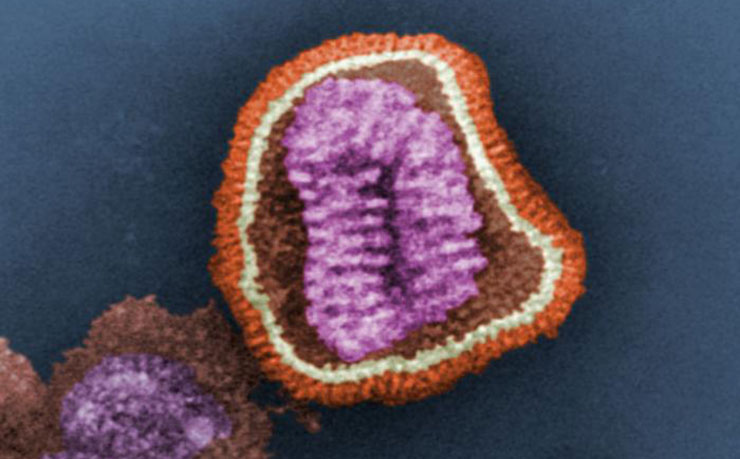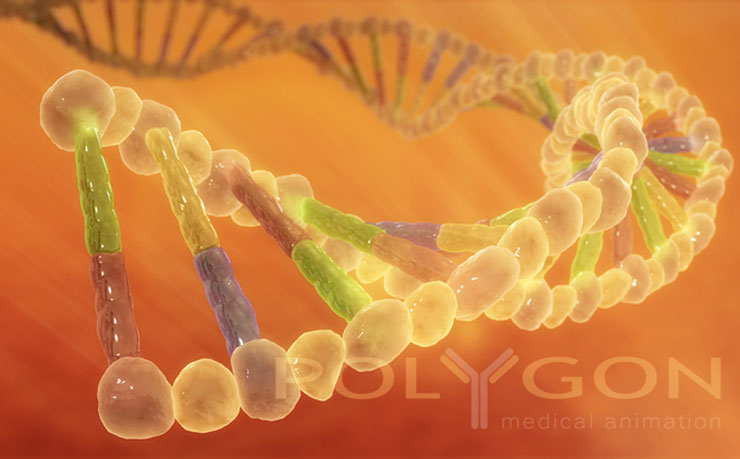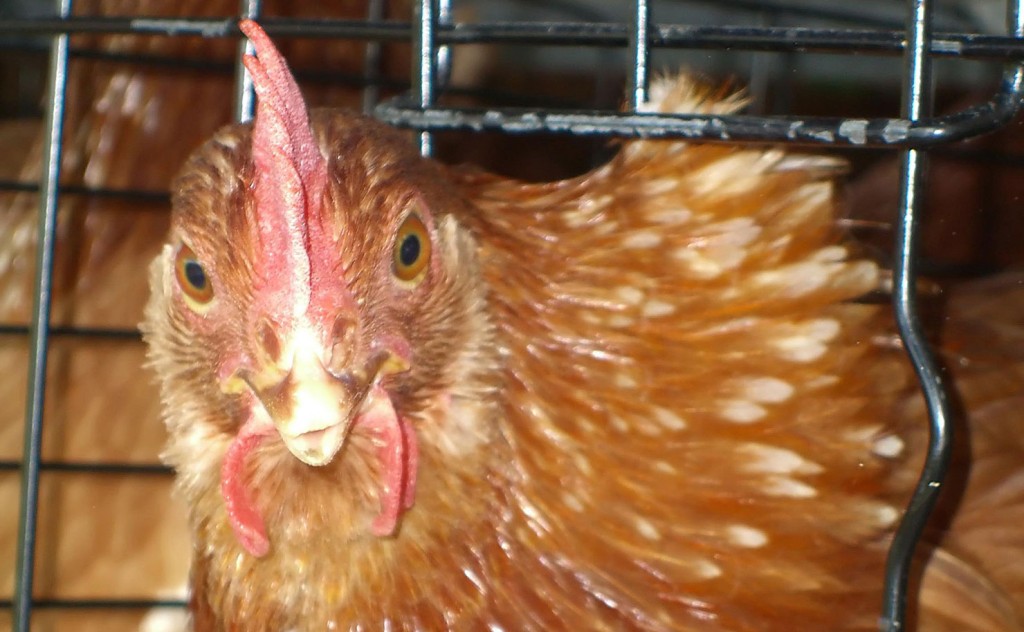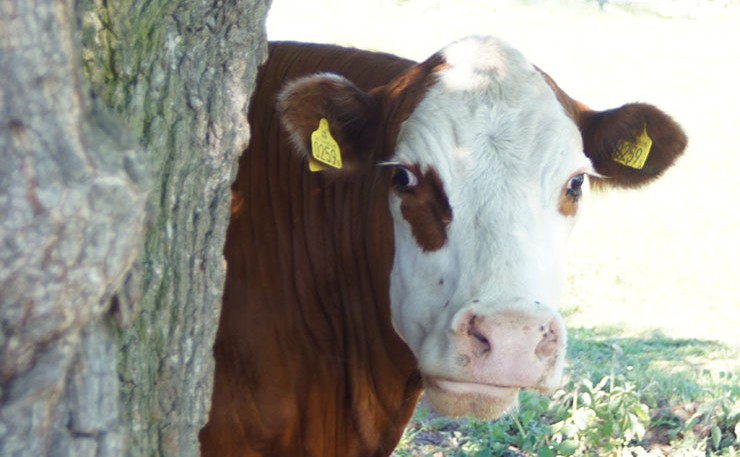There’s good GMO, and then there’s bad GMO. And there’s natural GMO as well. Geoff Russell gives you a simple guide to one of the really good ones which might one day remove meat from our diet.
CRISPR-cas9 is the name of a simple, cheap, highly precise set of tools for making all manner of changes to a cell’s DNA. It dominates the scientific press in much the same way that Donald Trump is occupying the popular media. But, unless Trump drops a bomb on North Korea, CRISPR will be transforming the world long after people have forgotten the Donald.
What’s it for?
Want to make mosquitoes that can’t carry malaria? Want to rid the planet entirely of one or more species of mosquito? A number of critically important species of food plants are under constant threat from pathogens. Bananas are a staple in parts of Africa but most of the world’s bananas are genetically identical and under constant threat from a soil fungus. Another decade could see them lose the battle and disappear from global diets.
Wouldn’t it be great to make bananas immune from that fungus? But why stop with bananas? Why not make humans resistant to HIV? Scientists now know the reason that some people are strongly resistant to HIV. They lack a particular small piece of DNA in a particular gene. Cut this out of other people and they too will be resistant.
Want to correct a gene defect in a child with Duchenne muscular dystrophy who would otherwise live a short life in considerable pain? There are tens of thousands of such diseases; none are common but the aggregate suffering is huge.
Want to turn a gene up or down to manipulate the amount of protein product it produces? A modified version of the technology can achieve this also.
These are just a few of the possibilities of CRISPR-cas9 being touted by scientists developing this new technology.
I’ve followed the hype surrounding genetic manipulation for decades and seen the noise rise to a crescendo and then invariably drop away to a low rumbling whimper. There are always a few grand and genuinely useful successes, but they never match the hype. But CRISPR-cas9 looks decidedly different; a technology which might just do what it promises.
In comparison, almost all previous GM techniques have been like trying to play a piano with a watermelon. The few with some precision have been slow, complex and expensive. But once you see how CRISPR-cas9 works, you might understand why it’s different.
The basic components of the technology weren’t invented by people at all. In fact, you could almost call it the ultimate in a natural genetic manipulation technology. They’ve come about through evolution, by natural selection operating on flesh eating bacteria. But these particular bacteria aren’t the only critters that know these tricks; they’ve been widely shared in the bacterial world over billions of years. They are part of the bacterial equivalent of our immune system. CRISPR-cas9 is simply a re-purposing and hacking of this bacterial tool kit.
Viruses can infect and kill bacteria. So evolution has done its thing and produced a defence mechanism. What do you need to target and kill a virus? First, a way of knowing you’re infected, and second, a way to kill the intruder. CRISPR (without the cas9) is a method of storing bits of viral material to use as a mug shot.
And the cas9? What’s it’s role? It’s a cutter; it deftly introduces a cut into both strands making up a DNA plait. This is unsurprisingly called double strand break, a DSB. What does your body do with DSBs? It repairs them. Sometimes it simply rejoins them, but if it finds some DNA with end points matching those of the cut, then it may insert that.
The cut point is ever so carefully controlled; the cas9 is guided into place by machinery which walks along DNA looking for regions matching point for point with the viral template from the CRISPR mug shot. When it finds a match, cas9 cuts. In bacteria, the mechanism operates like Edward Scissorhands, chopping viral DNA into harmless little pieces. But scientists have, in effect, turned off the repeat cycle.

Evolution has honed this tool for billions of years and it is both fast and precise, exactly the opposite of the kinds of genetic manipulations that have been around since the middle of the 1990s.
And the downsides? That’s like asking “What are the downsides of Chemistry?”. It tends to presume an accounting system where we list the pluses and minuses and use the bottom line to issue a red or green light to the entire field. It’s the classic anti-GMO false dichotomy.
A more sensible approach is to look case-by-case and measure the value of suggested applications against their risks. This is how we look at most technologies and it makes good sense.
GMO insulin is wonderful stuff, it saves human lives and spares the animals who pancreases used to be used for insulin. It’s also better than the animal derived insulin.
On the other hand it makes sense to be wary or downright antagonistic towards big chemical companies using market power to force farmers to sign coercive contracts to plant GM crops. Which doesn’t imply there’s anything wrong with the crops themselves.
Nonetheless, we can expect the anti-science lobby hiding in and behind the environment movement to start lobbying for CRISPR-free labelling laws some time soon. The way “GMO-free” is used on packaging makes it clear that there is a substantial market of binary consumers; people with a knee-jerk, slogan-based belief system.
Advertisers must estimate that a GMO-free label will attract more people than it will repel. Who could it repel? Perhaps some people object to the assumption that genetic modifications are always bad. Perhaps those people get really annoyed by sloppy thinking, whether in themselves or others.
The implication driving the anti-GMO movement is that our natural genomes are somehow terrific and anything which changes this natural order evokes instant and shrill opposition. This view that our genes are somehow optimal and worthy of eternal preservation in their many current states, was actually pretty close to the scientific consensus back in the 1950s. Back then, genes were thought to be stable and enduring entities with mutations being incredibly rare and invariably dangerous. Mutations, or persistent changes, were thought to occur “Perhaps once in a hundred thousand generations”.
As the decades passed, this was proven not just to be false, but laughably so. How did they get it so wrong? Viewing a clean city street could lead you to believe the city generated no garbage. The illusion of genetic stability was simply because we were largely blind to the detail and because vast amounts of damage were matched by extensive and unanticipated repair systems.

DNA damage estimates can seem quite different depending on the technical details of the type of damage being measured. But one estimate is that every cell is hit with about 10,000 pieces of DNA damage per day. Happily the clean up crew is excellent, but not perfect.
But how many genes get mutated? Meaning suffer a change that isn’t repaired and is passed on when the cell divides. All of them; but not in every cell.
All of the cells in your body have the same 20,000 or so genes and during the course of your lifetime every single gene gets mutated in about a billion cells in your body.
Each and every day babies pay for this daily natural genetic carnage by being born with assorted health problems. Some are trivial but others tragic.
Everybody knows about DNA mutations passed on from parents, but where do these come from in the first place? Somewhere, back in time, there is always a first ancestor with the mutation.
The official name for these mutations is de novo; changes to the DNA that aren’t in either of our parents but can be passed on to our children. Each of us is born with 40 to 80 of these in that single cell from which we begin our development.
The age of your father at the time of conception has quite a bit to do with it. Sperm is produced by cell division and each round increases the risk of mutation. I call it a risk, but it might be a good mutation, that’s the thing with mutations, they aren’t necessarily bad and most will be innocuous. But on balance, it’s best to pick a young dad. Your mum’s age doesn’t matter much. Her eggs don’t go through the series of divisions that drives the accumulation of mutations in sperm.
Understanding our genomes is the first step toward rational thinking about GMOs. The second step is understanding non-GMO foods. Think nuts, dairy, eggs and anaphylaxic shock, or red meat and bowel cancer. Every mouthful of beef or kangaroo or pig meat smashes your DNA and does it in a very particular way that can lead to bowel cancer.
People’s DNA repair mechanisms generally cope, but the more you roll the dice, the greater the risk of a repair failure. Faith in the innate goodness of that which is somehow natural, is just that, faith. And, like many faiths, its chief affliction is evidence deficiency syndrome.
Which brings us back to CRISPR-cas9. I’ve already compared it to other laboratory GM methods using the simple analogy of a watermelon. But what about traditional GM methods? By which I mean the methods of selective breeding used by farmers, racehorse owners, greyhound owners, and pet breeders.
Farmers, using selective breeding, have already produced horrors on a scale scarcely imaginable to any CRISPR-cas9 research group. Each year about 62 billion chickens are raised and slaughtered after spending most of their lives in pain. They have been bred to grow so fast that their skeletal system can’t keep up with their musculature.

We don’t have to imagine the risks of genetic technology going rogue. We know exactly what can happen because it’s been happening for over 60 years; it is already rogue.
I could also mention the pedigree pet industry who have managed to breed all manner of animals with dismal health outcomes. And what’s more, they’ve duped a gullible public into paying extra for the privilege of owning such animals. Perhaps if the veterinary industry didn’t make so much money out of these animals, they might have been more pro-active in opposition. But it’s a case of don’t bite the hand that feeds you.
The precision of CRISPR-cas9 makes it different from previous technologies, but the other big difference is cost and simplicity. Do it yourself CRISPR-cas9 kits are available on-line for US$150. The raw material mug-shot DNA is another $10-20.
Controlling technologies which are cheap and simple is virtually impossible. My favorite example is when sheep farmers in Australia got hooked on the idea that they could extend the productive life of sheep by sharpening their teeth with angle grinders. Every farm has an angle grinder.
Once the rumour was up and running, millions of sheep were subjected to the process, despite it not working. It took more than a decade to die away.
I suspect many CRISPR-cas9 scientists with a background in human medicine are naive about the way animal agriculture works. This is demonstrably true of Jennifer Doudna, one of the core people behind the discovery and re-purposing of the CRISPR-cas9 tools.
In her book “A crack in creation” she describes Belgian Blue cattle as a popular breed of cattle with a gene mutation for double muscling … meaning the ratio of meat to carcass is higher. Belgian Blue aren’t just body-builder like in their appearance, they are a welfare disaster. Their calves have heads that are too big to pass through the birth canal, so the rate of caesareans can be as high as 90 per cent. And it gets worse, if caesarean is considered a last resort, then it is only initiated after the birth process has started and isn’t going well.
Doudna, in her book, asks that people judge the results of CRISPR-cas9 for what they are, rather than for how they are achieved. I couldn’t agree more. It isn’t the method of breeding that makes the modern broiler chicken a cruel and vicious abomination, it is the distress and suffering.
I’d turn Doudna’s question around and ask her and everybody else involved in CRISPR-cas9 how they judge distress and suffering. Should it be judged for what it is in itself, or by the species in which it occurs?
Sixty years of factory farming indicates that farmers will use CRISPR-cas9 to enhance their bottom line with little or no regard to animal distress and suffering. The existence of farmers outside the norm who refuse to embrace modern breeds and techniques is as irrelevant to the debate as the occasional growing glacier is to the climate change debate.
Despite the risk to animals from both traditional and modern GM techniques, Doudna and others list animal agriculture among their list of target fields. They also throw in food security as a goal.
The contradiction here is that you have to choose, do you want enhanced global food security or an increase in animal production? The two goals are diametrically opposed.
Animals compete right now with humans for food and generally win. Modern broilers typically have a feed mix that has more than double the protein of a developing world diet, in addition to being supplemented with a full range of vitamins and minerals.
Jennifer Doudna’s lab is at the University of California Berkeley. Not far away is the lab of another biochemical super star, Patrick Brown. Both have Howard Hughes Institute funding.
Brown has been thinking about the links between food, the climate and the general environment for quite a long time. He retired a few years back and assembled a team of brilliant biochemists plus some Bill Gates funding to develop plant-based burgers. His goal is nothing less that total elimination of animal products from the diet.
Brown understands that the general environmental and climate change imperatives demand nothing less. His burgers are a little different from the bean-based burgers I’ve been known to make. His smell like meat, taste like meat and even bleed like meat. Ironically, he’s called his company Impossible Foods.
Brown has used GMO technology to make a version of heme iron for his burgers that gives them that particular meaty taste. He also has people working on replicating the unique properties of egg and milk proteins.
As with GMO insulin, his meats will be better than the real thing. They will also be far more environmentally benign and, in due course, cheaper.
I don’t see a way of controlling rogue farmers deciding to use CRISPR, other than to price them out of the market. Hopefully they’ll all switch to growing the plant raw materials for Impossible foods!
Donate To New Matilda
New Matilda is a small, independent media outlet. We survive through reader contributions, and never losing a lawsuit. If you got something from this article, giving something back helps us to continue speaking truth to power. Every little bit counts.






